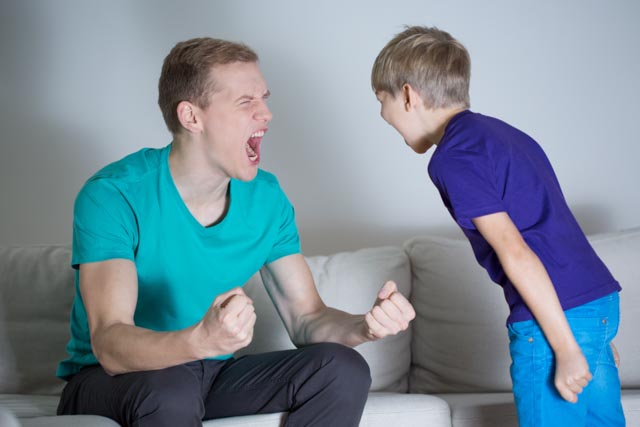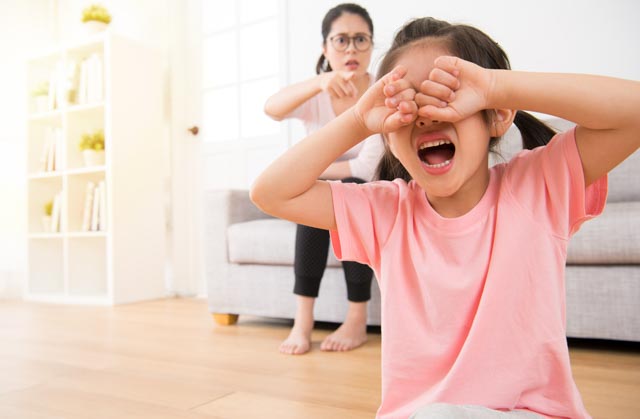Blog
What To Do When Your Child Throws A Fit
“Noooo! I don’t want to do that!” All you hear is screaming and yelling. Hands flail up and down, nearly hitting you in the face. The child in front of you is clearly upset.
If you’re a parent or someone who works with children, you’ve most certainly encountered an angry or upset child. In this situation, nobody feels good, but it’s possible to still have a positive outcome. So what should you do in this situation?

Regulate your own emotions
Our first instinct may be to tell the child to be quiet and calm down. Or, even worse, we may lash out and yell back. How dare a kid raise his or her voice at an adult, right? That’s just plain disrespectful.

This child is out of control! You may be tempted to take back control as soon as possible. You may feel your own anger rising.
But yelling isn’t the best option here. Yelling may activate the child’s “fight-or-flight” response, and the child may freeze up or run away. That isn’t the result we’re looking for, especially when our current goal is to calm the child.

Take a deep breath—this will help increase the oxygen supply to your brain and promote a sense of calmness. Remember that you are demonstrating how to be calm and collected to your child. If you are frustrated or upset, or if you yell, this will only send the message to your child that this is how adults behave, which will encourage your child to act the same way as he or she emulates the role models and adults in his or her life. Take a moment to relax yourself so you are ready to speak in a calm, even voice to your child when he or she is ready, which means waiting until your child is not screaming and is able to listen.

Attempting to suppress the child’s anger may only escalate the situation even more, and talking to an upset child while he or she is still crying will not lead to any learning for the child and may even frustrate the child further. It may also lead to frustrations for you, so tell your child that you are going to give him or her one to two minutes to calm down before you will talk together. Your goal here is to calm the child down—not make him or her even more upset!
Sit down with the child
Take a seat—both of you. Physically show the child that you are by his or her side and that you will be there to support him or her if needed. Some children may feel safer if you are by their side, but others may find it easier to calm down on their own terms. In that case, keep the child in a safe space and show the child what he or she can do during this “calm down period.” Try showing the child how to take slow breaths or to count to 10. Then, give the child some time to calm down before speaking to him or her.

Breathe slowly. If you slow down your own breathing, the child will likely slow down his or hers to match yours. Take this as an opportunity to calm down yourself and also calm down the upset child.
Create the sense of safety by adjusting the tone of your voice and the way your body is positioned. You want to avoid cradling your child because if children are coddled each time they throw a fit, they may associate this behavior with extra attention. Instead, sit face-to-face with the child. By aligning your line of sight to the child’s, you create a sense of closeness. Use a soft tone that questions the child’s anger rather than interrogates. This way, the child will feel less intimidated in this situation and ease up.

Validate their feelings and experiences
“I can see that you are upset right now. I am here for you.”
Rather than reprimanding the child, let the child know that it is okay to have these emotions. When children know that you understand their emotions, they don’t feel the need to further demonstrate their anger by throwing a fit, yelling, or crying. Instead, acknowledging a child’s feelings is a great way to get him or her to open up to you. After the child is able to express his or her feelings, you can address alternate ways to let others know these feelings in the future, rather than throwing a fit or screaming. (These will be discussed in a future post, but some examples are teaching ways to talk about our feelings, taking a minute to calm down before talking, and going to a quiet spot and taking slow deep breaths.)
Remember that you are first acknowledging the negative emotions rather than the bad behavior. While you may feel the impulse to critique the tantrum, keep in mind that your current priority is to understand the situation. “You must be so upset to speak to me like this. Can you tell me first what’s making you so upset? Then we can figure out what we can do about it.”
Understanding the situation
Is this kid really upset about not being able to play with the Lego pieces? Or am I misreading the situation?
Ask clarifying questions about the source of this chaos, or try repeating what the child says to you. This will give you a better understanding of the situation, and it will clarify any misunderstandings you may have about the episode.
“What happened?”
“Are you upset because Timmy took your toy?”
Here are a few things to remember about situations like this:
1. Many small children cry or act frustrated or upset when they are tired. Sometimes the root issue is that the child needs more sleep each night.
2. Children need to learn how to have appropriate interactions with others, including times when they do not get what they want. (We will expand on this topic further in future posts!)
3. Children need to learn coping skills for handling frustrations. This will not be learned through one interaction like this, but will take time and practice. Be patient!
Acknowledge their efforts
It seems odd, right? What could the upset kid possibly have done right to deserve acknowledgement?
For one, the child calmed down. You can say, “Thank you for calming down.”
Also, the child expressed his or her feelings, “I appreciate you telling me this.”
Recognize children’s positive behaviors. This will show them what they should do the next time they feel these emotions.
Save the lessons for later
As mentioned earlier, there is no use trying to reason with an upset child. An upset child may not be ready to listen or think, and talking over loud crying or screaming will only exhaust both of you. If the child still seems upset, you may want to first revisit the steps above to calm down and then figure out these emotions.
Once the child is calm, he or she is ready to problem solve. Refrain from giving exact instructions for what he or she should do next time! Instead, get the child thinking by asking, “What can you do next time when someone takes your toy away?” Allow the child to come up with his or her own solution. For example, “I can say ‘Please ask first.’” A solution that gets the child thinking and incorporates his or her ideas will stick better, and the child will feel more in control! When a child feels in control, he or she will feel more grown-up and have more confidence in him or herself. Through encouraging the child to generate solutions on his or her own, the child will also develop a better understanding of how calm behavior will lead to more favorable outcomes.

When we’re faced with an angry child, it can be difficult to figure out what to do. you must remember that the number one goal is to calm the child first, rather than to reprimand or lecture. By calming the child, you enable yourself to be heard. Then you may proceed with the next step: to understand the situation. What happened? What led to this frustration? Only when you understand the situation and figure out the underlying issues will you be able to work out a solution with the child. And give the child a sense of control by letting the child figure out these solutions on his or her own! With guided practice, the child may be able to figure out the right steps to take the next time a distressing situation happens!